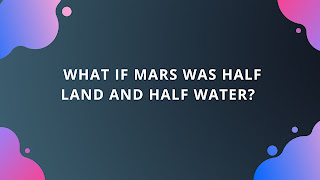What if Mars was half land and half water? Imagine the possibilities!
What if Mars was half land and half water? Just imagine the possibilities! It’s an intriguing thought, especially when you consider that Mars is a planet with a lot of potential. Mars is the closest planet to Earth, and its geographical features suggest that it could be an ideal spot for human exploration and colonization in the future. With the right technology and resources, the possibilities of what we could do with a planet that is half land and half water are virtually endless. So, let’s dive into this concept and explore the potential of what could be done on Mars if it were half land and half water.
The Geography of Mars
Mars is the fourth planet from the Sun and is known as the “Red Planet” due to its rusty, reddish-brown appearance. Although the surface of Mars is predominantly dry and dusty, there is evidence that it once held vast amounts of water billions of years ago. Today, however, what little water exists on the planet is locked up in underground ice and permafrost.
If Mars was split between half land and half water, it would provide a fascinating opportunity to study the dynamic landscape of a planet with two distinct climate zones. The red planet’s low gravity and atmosphere would mean that the water could form vast oceans, lakes, and seas that cover nearly half the planet’s surface.
The shorelines and coastlines of this new Martian ocean would be constantly shifting and reforming due to the planet’s very slow rate of rotation, creating an ever-changing geography. We may also see fascinating geological features such as sand dunes, mud flats, salt flats, and even coral reefs!
There are numerous possibilities for how this new Martian geography would develop. What’s certain, however, is that we would be able to explore a strange and wonderful new world filled with incredible wonders that have never been seen before.
The Climate of Mars
The climate of Mars is much colder than the Earth’s, with an average temperature of -81 degrees Fahrenheit. It is generally dry, with the atmosphere consisting mostly of carbon dioxide and traces of other gases like nitrogen and argon. Mars also has a very thin atmosphere, which makes it difficult for water to exist in its liquid state. In fact, any water that does exist on the surface of Mars is likely to be frozen beneath the surface.
Given these conditions, it is unlikely that Mars would have an abundance of liquid water if it was half land and half water. The atmospheric pressure on Mars is also much lower than on Earth, so any large bodies of liquid water would evaporate quickly into the atmosphere. However, there could still be some small pockets of water in regions where temperatures and pressures are higher.
Overall, the climate of Mars would be significantly different if it was half land and half water. With more water in its atmosphere, temperatures could become milder and more conducive to life. The atmosphere could also become thicker, allowing for more diverse habitats and ecosystems to form.
The Possibilities for Life on Mars
If Mars was half land and half water, it could open the door to possibilities for life on the planet. Without the extreme temperatures and lack of liquid water that Mars currently has, the environment may become much more hospitable to life. Scientists theorize that if Mars had an atmosphere like Earth’s, there would be liquid water on the surface and the possibility of some kind of life forms existing on the planet.
The presence of liquid water could also make it easier for exploration missions to Mars. With access to liquid water, spacecraft would be able to refuel and replenish their water supplies at a much faster rate, allowing them to travel farther and stay longer in space.
Furthermore, with an atmosphere like Earth’s, Mars could potentially have a magnetosphere like Earth’s, which would protect the planet from solar radiation. This could make it easier to send astronauts and robots to explore the planet’s surface without risking their health and safety.
It is impossible to know for sure what kind of life forms might exist on Mars if it was half land and half water, but the possibilities are exciting and worth exploring. With further research and technological advancements, who knows what we may discover about our closest planetary neighbor in the future?
The Implications for Earth
If Mars was half land and half water, the implications for Earth could be enormous. We would gain access to a whole new planet with an entirely different environment than our own. With a half-land and half-water composition, there is potential for a completely different type of life on Mars. This could lead to a number of discoveries that could benefit humanity.
For example, if there were organisms on Mars that could survive the extreme temperatures, they could provide insights into developing treatments for diseases that can’t be cured with existing methods. Additionally, we could learn more about our own planet through studying the geology of Mars. Finally, exploring this new planet could yield invaluable resources that could help to solve the energy crisis on Earth.
By exploring the possibilities of life on a planet with half land and half water, we would be opening up new pathways for scientific advancement and knowledge. Our understanding of space and the universe would be greatly enhanced. Ultimately, understanding a new environment on Mars could lead to discoveries that can benefit us all.
